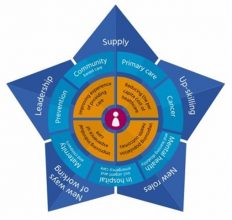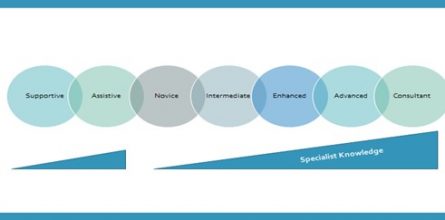HEE South East Workforce Transformation team uses a number of different tools to drive change and improvement in, and across, the six ICSs within the South East. Utilising education and development as a prime enabler of workforce transformation, we support ICSs to identify innovations and solutions that address workforce challenges.
HEE Star
The HEE Star is a key tool developed by HEE to bring structure and coherence to conversations about workforce challenges and to support workforce transformation.
The primary function of the HEE Star is to be an organisational development tool, enabling a comprehensive diagnostic of workforce requirements and better definition and prioritisation of solutions. Secondly, it’s an interactive resource, showcasing offers and products from HEE to fulfil a chosen solution.
To find out more about the HEE Star visit Star TV or the Star webpage.

Patient Learner Journey
The Patient/service user and Learner Journey’s are conceptual maps to help teams think differently when having discussions about workforce and workforce needs. It enables visualisation of these needs in a different way- starting with the patient/service user or service user.
The concept maps provide insight and enable visualisation into the relationship between the workforce as learners (formal/informal/ lifelong learning) at different levels of practice and capability, and the patient/service users journey through health and care systems and services. These concept maps can be used to support workforce optimisation and redesign and consider opportunities for transformational change. Its use is intended to help in situations when you need to generate ideas and solutions and think creatively about, for example;
- Deciding when to support and invest in new roles or whether and how to upskill existing workforce
- Thinking about how to support the implementation of policy such as the Long Term Plan or enabling elective recovery
- Looking at deploying the workforce creatively and across organisational boundaries on the basis of capabilities and levels of practice for maximum impact on the patient or service user journey
- Anticipating the education and training needs of the current and future workforce.
Using the learner journey and mapping it against the patient/service user journey, allows visualisation all elements of the workforce as learners at every point in that journey. It also allows for consideration of the wider workforce and their development needs. For example, often when employers are looking to introduce new roles, or considering upskilling to meet a need, the starting point is usually the existing workforce or service need, rather than taking the opportunity to look at the patients’ /service users needs as the driver for change. By considering the capabilities and level of practice required for the patient/service user in their journey, it is easier to see whether a new role is needed or whether and how, existing staff can be upskilled or redeployed and supported in their development to meet those needs. It can also help to consider where a skill or capability is needed in that patient/service users pathway that can make the difference to outcomes, experience or to change the trajectory.
The Learner journey builds on the Talent for Care framework and illustrates the stages of career trajectory as levels of practice and complexity of work and expertise, where the pillars of practice grow and develop over that persons career. These stages can be further stratified to include the below levels of practice (Alison Leary, Sep 2019, https://www.lscthub.co.uk/wp-content/uploads/2021/10/Enhanced-PracticeREPORTFINALWOAppx.pdf )

Across this journey it is possible to see transition points where interventions can make a difference to the trajectory, direction and continuation of that career into different pathways or different careers along these pillars such as education, or research. Essential to the journey of development are the key roles that support and enable learners and learning in practice such as supervisors, educators and mentors. They too are developing their skills and expertise along the education pillar for example. The patient/service user journey and learner journey can be used in conjunction with the workforce tool and methodology of the HEE Star and can often lead to more focussed Star workshops to fully explore specific areas in more detail across the 5 workforce domains.
To find out more information visit the Patient Learner Journey